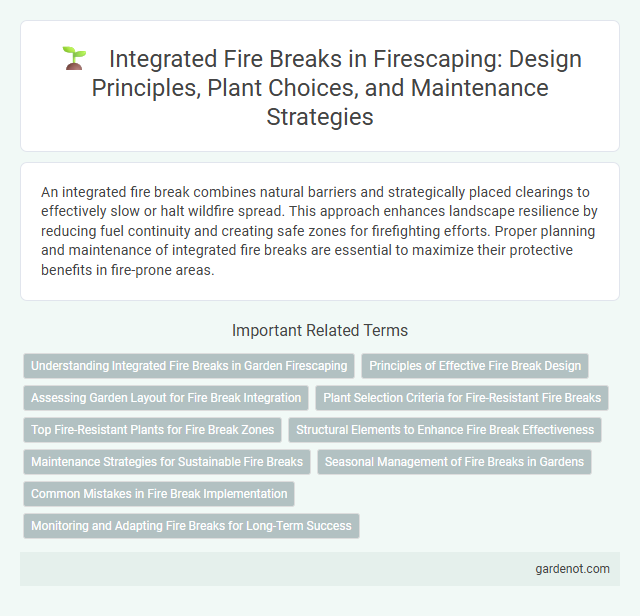An integrated fire break combines natural barriers and strategically placed clearings to effectively slow or halt wildfire spread. This approach enhances landscape resilience by reducing fuel continuity and creating safe zones for firefighting efforts. Proper planning and maintenance of integrated fire breaks are essential to maximize their protective benefits in fire-prone areas.
Understanding Integrated Fire Breaks in Garden Firescaping
Integrated fire breaks combine strategic vegetation spacing, fire-resistant plants, and non-flammable materials to create effective barriers against garden wildfires. These fire breaks reduce fuel continuity by interrupting the spread of flames and embers, minimizing fire intensity near structures. Implementing layered fire breaks with gravel paths, stone walls, and low-growing succulents enhances fire resistance and protects property in fire-prone landscapes.
Principles of Effective Fire Break Design
An integrated fire break incorporates strategic vegetation management, topographical considerations, and ignition-resistant materials to create a defensible boundary against wildfire spread. Effective fire break design prioritizes sufficient width, continuity, and accessibility for firefighting efforts while ensuring minimal ecological disruption. Incorporating moisture-retentive plant species and maintaining regular clearance enhances the fire break's resilience and long-term functionality.
Assessing Garden Layout for Fire Break Integration
Assessing garden layout for integrated fire break involves analyzing plant placement, types, and spacing to minimize fuel continuity and reduce fire spread risk. Incorporating low-flammability vegetation and strategic hardscape elements enhances fire resistance while maintaining aesthetic appeal. Precise evaluation of slopes, wind patterns, and access points further optimizes fire break effectiveness within landscaping design.
Plant Selection Criteria for Fire-Resistant Fire Breaks
Choosing fire-resistant plants for integrated fire breaks hinges on their low flammability, high moisture content, and minimal resin or oil presence. Species such as deciduous trees, succulents, and certain native shrubs are preferred for their ability to reduce fire spread and serve as effective barriers. Optimal plant selection enhances landscape resilience by creating strategically placed, combustible-free zones that interrupt wildfire pathways.
Top Fire-Resistant Plants for Fire Break Zones
Integrated fire breaks utilize top fire-resistant plants such as manzanita, California fuchsia, and succulents like agave, which exhibit low flammability and high moisture content. These plants create effective barriers by reducing fuel continuity and slowing fire spread in fire break zones. Incorporating drought-tolerant, native species optimizes fire break performance and supports ecosystem resilience.
Structural Elements to Enhance Fire Break Effectiveness
Structural elements such as gravel paths, fire-resistant walls, and non-combustible fences significantly enhance the effectiveness of integrated fire breaks by creating physical barriers that prevent fire spread. Incorporating materials like stone, concrete, and metal within these elements reduces fuel load and interrupts flame continuity. Properly designed structural components complement vegetation management, ensuring a robust defense against wildfires.
Maintenance Strategies for Sustainable Fire Breaks
Integrated fire breaks require regular inspection and removal of accumulated vegetation to maintain their effectiveness in wildfire prevention. Strategic mowing, pruning, and controlled burning reduce combustible materials and ensure clear boundaries that inhibit fire spread. Incorporating native, fire-resistant plants within fire breaks supports long-term sustainability by reducing maintenance frequency and enhancing ecosystem resilience.
Seasonal Management of Fire Breaks in Gardens
Seasonal management of integrated fire breaks in gardens involves strategic pruning, removal of dry vegetation, and regular clearing of debris to reduce fuel loads during high-risk fire periods. Implementing a rotation schedule aligned with seasonal growth cycles ensures fire breaks remain effective while preserving garden health and biodiversity. Consistent monitoring and maintenance during dry seasons enhance the garden's resilience against wildfire spread.
Common Mistakes in Fire Break Implementation
Common mistakes in fire break implementation include inadequate width, which fails to stop the fire's spread effectively, and improper placement that does not consider prevailing wind directions and vegetation types. Using combustible materials within the fire break zone or neglecting regular maintenance leads to increased fire risk instead of mitigation. Ensuring fire breaks are properly designed, located, and maintained is critical for effective firescaping and wildfire protection.
Monitoring and Adapting Fire Breaks for Long-Term Success
Regular monitoring of integrated fire breaks involves assessing vegetation regrowth and soil conditions to prevent breach risks. Adaptive management strategies include periodic clearing and redesigning based on real-time fire behavior data and environmental changes. Employing remote sensing technology enhances early detection of vulnerabilities, ensuring fire breaks maintain effectiveness over time.
Integrated fire break Infographic

 gardenot.com
gardenot.com